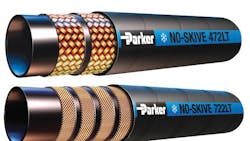New 472LT and 722LT hoses work in temperatures from –70°F to 212°F (–57°C to 100°C). They are designed for high-impulse, applications. The 472LT is available in 1⁄4- to 1-in. sizes. No-skive, two-wire braided hose is rated for pressures to 5800 psi (40 MPa). Rated up to 4000 psi (28 MPa), the no-skive, four-wire spiral 722LT is available in sizes from 3⁄8 to 2 in. Both use 43 series fittings; 722LT also uses 71 series. Both feature a half-bend radius.
Parker Hannifin Corp., Hose Products Div., (800) 272-7537, bit.ly/hp512parker
About the Author
Sign up for our eNewsletters
Get the latest news and updates

Leaders relevant to this article:

